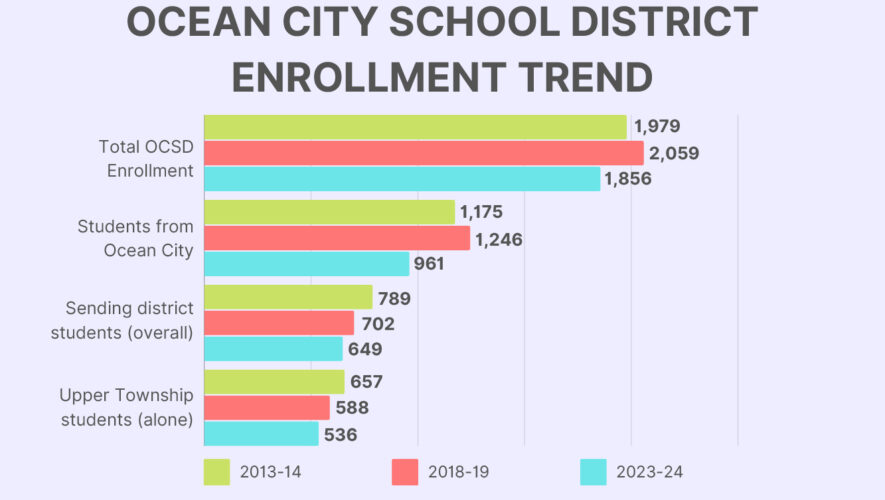Despite declining enrollment, state aid consistent, unlike other districts
Editor’s note: The statistics in this story are from an Open Public Records Act (OPRA) request made by Sentinel reporter David Nahan and fulfilled by Timothy E. Kelley, business administrator for the Ocean City School District.
OCEAN CITY — Over the past 10 years, School Choice has brought in about 194 students each year to the Ocean City School District. With them came more than $27 million in School Choice aid.
Because of the state’s school aid funding formula, other area districts have been suffering through severe budget cuts, affecting teachers and programs, combined with substantial tax hikes, but the Ocean City School District (OCSD) has been unscathed.
That is because school officials made the choice for School Choice about 15 years ago and pursued it aggressively, becoming one of the top three districts in the state in terms of the number of students it accepts.
RELATED STORY: Where Choice students are from
RELATED STORY: Other districts facing cuts
RELATED STORY: Survey shows Choice parents positive about OCHS
The OCSD has long been in a sending-receiving relationship with neighboring districts, accepting high school students from Upper Township, Corbin City and Longport, and K-12 students from Sea Isle City.
Over the same 10-year period — school years 2014-15 to 2023-24 — tuition revenue from those sending districts totaled $116,508,557.
The total in regular state aid to Ocean City in those 10 years was $12,856,209. That is less than half of the $27,128,489 the district received in Choice Aid from the state.
Regular state aid to the Ocean City district has slowly increased over the decade, from $1,084,399 in 2014-15 to $1,590,489. The School Choice aid over the decade has been relatively stable, with a low of $2,629,127 in 2019-20 to a high of $2,938,906 in the school year that just finished.
While the nearby Upper Township, Somers Point and Mainland Regional school districts were slashing teachers and programs from their budgets because of ongoing state aid cuts, the Ocean City district has been insulated on the total state aid side largely because of the School Choice money.
That means the OCSD has been able to maintain a wide range of offerings even though the number of island residents in the district has been declining, as has the number of students from the sending districts.
“If we break it down, (Choice) brings in over $2.7 million in revenue each year,” district Business Administrator Timothy E. Kelley said. “I would say the Choice program allows us to maintain and provide a wider variety of course offerings for students, be it electives or AP (courses.). It broadens our horizons and lets us offer programs that without that funding we would have to decide what would stay.”
He and Interim Superintendent of Schools Terrence Crowley said they were aware of what has been happening in some of the neighboring districts without as substantial Choice programs.
Crowley, a longtime administrator in the Kingsway School District and the Cape May County superintendent of schools from 2007 to 2011, said the way the state provides aid to districts is hurting education, especially where student bodies have been declining.
In the 2013-14 school year, there were 1,175 students from Ocean City in the district. In the 2018-19, that number was 1,246. By this school year, the number had dropped to 961.
Overall, the school district had 1,979 students in 2013-14, 2,059 in 2018-19, but only 1,741 in the 2022-23 year. There are 1,856 students in the district this school year.
Enrollment at the high school was 1,151 in 2013-14, $1,194 in 2018-19 and 1,131 in 2022-23. The drops were more pronounced in the other schools. The intermediate school had 472 students in 2013-14, but ony 345 in 2022-23 and the primary school was at 357 in 2013-24 but only 265 in 2022-23.
The number of students from Upper Township at the high school dropped from 657 in 2013-14 to 536 this school year.
That declining enrollment has severely hurt the Upper Township district’s state aid, but the overall drop in the Ocean City School District, 10 percent since 2018-19, has not. Neither has the fact the number of students from within the community has fallen by nearly 23 percent from 2018-19.
Chalk that up to steady School Choice aid.
“One of the things I was told to do when I was county superintendent was to form regionals, eliminate non-operating districts — no more K-6 or K-8 — and we (superintendents) said, ‘You’re going to have to have a lot of community input, a lot of discussion.’ And they said, ‘No. Just go ahead and do it.’ You just can’t go ahead and do it,” Crowley said.
“I’ve said this many times: I wish the state would make up their mind. If you want county school districts, make county school districts and fund them because this death by a thousand paper cuts is hurting kids. If that’s not your goal, then fund these districts appropriately,” Crowley said.
When he became a county superintendent, the state’s goal was to consolidate smaller districts into large ones, a goal that has never been reached. He and Kelley said there has been only one district in New Jersey, in Hunterdon County, that has consolidated.
“It’s still the law that says the county superintendent has to merge all school districts into K-12 but there’s never money to do it,” Crowley said.
“Under the current situation, if you look at Upper or any of them across the state, what they’re doing is horrible for kids. I don’t care what the district is. Fund them appropriately,” he said.
Because so many districts across the state have been losing so much aid and have been forced to make drastic cuts in the 2024-25 budgets, the state relented this year and is providing a return of 45 percent of the money that was cut for the upcoming year. It also allowed districts to exceed the tax levy increase cap to as much as 9.9 percent.
Kelley said that is a one-time opportunity.
“With this whole cap issue, if you don’t think (the districts) are paying their fair share, let the district rise to what you think the fair share is and raise the taxes. I know that is anathema, but if you want your own school, that’s what they have to do,” Crowley said.
He noted the unpopularity of that option, which some local districts are exercising.
“It’s a tough nut. How do you go to your community and say you’re raising taxes 10 percent? Once again, it’s a big policy decision. If you want to get rid of little districts, get rid of them, make them merge, but pay for it,” Crowley said.
He explained he has conducted regionalization studies and there are winners and losers under the current regulations, depending on the communities involved and how that affects them.
“Until we change that, nobody is going to voluntarily say, ‘I want to merge with you and I know it’s going to cost me a thousand dollars more a year. Nobody is going to do that,” Crowley said.
Once again, it’s a policy decision at the state level.
“I was on a regionalization committee, probably in 1994, and that study is still on a shelf somewhere in Trenton along with the other 12 that they did,” Crowley said.
When districts are forced to make budget cuts because of declining state aid, some are OK, such as eliminating courtesy busing, but “when you’re cutting programs, you’re cutting activities, you’re cutting teachers, that’s direct services to kids. They’re the ones getting screwed. It’s the kids who are going to get the short end of the stick and they’ll have to compete against a district that has all that stuff. How is that fair?
“Until the politicians say this is what we want and this is what we’re going to do, we’re going to go in circles. And we’ve done it for years,” Crowley said. “For years.”
Neither Crowley nor Kelley believe there is a likelihood of New Jersey expanding the School Choice program, allowing districts to take on more students.
“I’m not a political predictor … but currently I don’t think there is any opportunity that they want to expand any of the Choice program,” Crowley said.
“Ideally it would be something to consider, but I don’t see it happening,” Kelley said.
– By DAVID NAHAN/Sentinel staff




